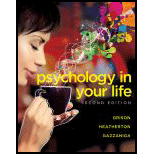
To determine:
Can people learn to detect micro-emotions? Who might be better at this skill?
Concept introduction:
Facial expressions can tell us a lot about a person and the emotions they are experiencing. Being able to read a person’s emotions based on what we see can help us determine who we can trust, if someone is lying to us, or how someone is feeling. Understanding other people’s emotional states impacts our behavior. If we see a friend is sad, we will hug them and talk to them. If a detective can tell a suspect is lying or untrustworthy, they may bring them in for further questioning.
Explanation of Solution
Suggested responses:
Paul Ekman is famous for his study of emotions and facial expressions. He carefully studied the small facial muscle movements that create facial expressions and convey emotions. The untrained eye can detect a number of emotions such as anger, sadness, joy, disgust, shame, etc. But, psychologists such as Dr. Ekman and other trained professionals have learned to detect micro-emotions—the small, nonverbal cues that can be observed by carefully analyzing facial muscles. Some people may have more talent for detecting micro-emotions, but the skill can also be taught. Dr. Ekman himself has developed training tools and programs to teach people how to read micro-emotions. Additionally, specialized rehabilitation programs that treat patients with stroke and brain injury (particularly in the right hemisphere of the brain) often use emotion, or affect, recognition training programs because these injuries often impair a person’s ability to recognize facial expressions and emotions. In both cases, training can involve carefully studying photos of people’s faces, identifying important areas of the face where muscles move or change (for example, around the eyes and mouth), and learning to associate certain emotions with specific facial patterns. Training may start with simple emotions and become more complex. It may also start with pictures, then advance to photos and in-person interactions.
Having a strong, active amygdala may make someone a fast learner when it comes to micro-emotions, as the amygdala helps process emotions and interpret facial expressions. Additionally, someone who has high emotional intelligence (discussed on page 291) is good at understanding emotions in both themselves and others, which could make learning micro-emotions easier. Someone who has a brain injury, visual problems, or low emotional intelligence would likely have a harder time learning to distinguish micro-emotions.
Want to see more full solutions like this?
Chapter 9 Solutions
Psychology in Your Life (Second Edition)
 Ciccarelli: Psychology_5 (5th Edition)PsychologyISBN:9780134477961Author:Saundra K. Ciccarelli, J. Noland WhitePublisher:PEARSON
Ciccarelli: Psychology_5 (5th Edition)PsychologyISBN:9780134477961Author:Saundra K. Ciccarelli, J. Noland WhitePublisher:PEARSON Cognitive PsychologyPsychologyISBN:9781337408271Author:Goldstein, E. Bruce.Publisher:Cengage Learning,
Cognitive PsychologyPsychologyISBN:9781337408271Author:Goldstein, E. Bruce.Publisher:Cengage Learning, Introduction to Psychology: Gateways to Mind and ...PsychologyISBN:9781337565691Author:Dennis Coon, John O. Mitterer, Tanya S. MartiniPublisher:Cengage Learning
Introduction to Psychology: Gateways to Mind and ...PsychologyISBN:9781337565691Author:Dennis Coon, John O. Mitterer, Tanya S. MartiniPublisher:Cengage Learning Psychology in Your Life (Second Edition)PsychologyISBN:9780393265156Author:Sarah Grison, Michael GazzanigaPublisher:W. W. Norton & Company
Psychology in Your Life (Second Edition)PsychologyISBN:9780393265156Author:Sarah Grison, Michael GazzanigaPublisher:W. W. Norton & Company Cognitive Psychology: Connecting Mind, Research a...PsychologyISBN:9781285763880Author:E. Bruce GoldsteinPublisher:Cengage Learning
Cognitive Psychology: Connecting Mind, Research a...PsychologyISBN:9781285763880Author:E. Bruce GoldsteinPublisher:Cengage Learning Theories of Personality (MindTap Course List)PsychologyISBN:9781305652958Author:Duane P. Schultz, Sydney Ellen SchultzPublisher:Cengage Learning
Theories of Personality (MindTap Course List)PsychologyISBN:9781305652958Author:Duane P. Schultz, Sydney Ellen SchultzPublisher:Cengage Learning





